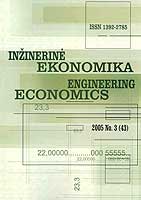The Principles of Exporter-Provided Trade Credit Risk Model
The Principles of Exporter-Provided Trade Credit Risk Model
Author(s): Jūratė Pridotkienė, Gabrielė Snieškienė, Vytautas SnieškaSubject(s): Economy
Published by: Kauno Technologijos Universitetas
Keywords: export; trade credit risk; risk assessment; exporting pricing
Summary/Abstract: The issue of trade credit risk evaluation, from an ex-porter‘s point of view is analysed in the article, i.e. sources and evaluation possibilities of the risk. Assessing exporter-provided trade credit risk, it is essential for the exporter to identify to which obligor it is rather safe to provide trade credit (negligible or moder-ate default probability) and which obligor has large probability to default. Credit risk evaluation for exporting companies is more complicated than for firms trading with local partners only, because of the following reasons: firstly, customer is located in another country and therefore it is more compli-cated to get information about customer‘s reliability. Sec-ondly, there are more factors influencing exporter‘s credit risk as the credit risk is influenced by foreign country‘s political situation, economic stability, etc. Exporter experiences the largest impact and, there-fore, losses in the case of customer’s (obligor’s) default, since the creditor (exporter) has a scarce probability to get the money back. Therefore one of the main factors evaluat-ing trade credit risk is obligor’s default risk assessment. As the obligor and creditor are from different coun-tries, the credit risk arises both from the obligor’s inten-tions and financial situation (internal risk factors) and from obligor’s business environment in his country (ex-ternal risk factors). Internal factors of obligor default involve activity, competence, reaction to environment changes and moral attitudes towards exporter of company’s management and employees. Dishonest intentions, however, cannot be expressed mathematically, therefore this aspect of the risk is not analysed in the article. External factors of international trade credit risk in-volve economic and political risk. Complex gathering and analysis of information about foreign country political and economic stability (country risk) is time and money intensive. Country risk can be evaluated by means of sovereign credit ratings provided by world-known credit rating agencies. Obligor’s individual failure probability can be evaluated by the use of various failure risk models. Sta-tistical models based on discriminant analysis and “theo-retical” failure risk models are received as classical ones. Alternative models, like expert systems, hazard and neural network models are also employed in credit risk analysis. Trade credit risk evaluation is very important for risk-based export pricing. With risk-based pricing cus-tomers (obligors) are charged according to the default risk they present.
Journal: Engineering Economics
- Issue Year: 2006
- Issue No: 2 (47)
- Page Range: 7-14
- Page Count: 8
- Language: English

